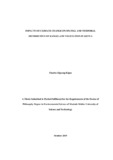| dc.description.abstract | ABSTRACT
Rangeland vegetation are important resources for livestock, wildlife and human beings and are largely influenced by climatic conditions. The effects of climate change are varied and among them is uncertainty in dynamics of rangelands vegetation. The rangeland vegetation in Kenya supports the key economic activities of livestock and tourism. This significant contribution to GDP underscores the need to model the impacts of climate change on the rangeland vegetation for the country to promote sustainable development. This study analysed the spatio-temporal trend of rainfall and vegetation from 2001 to 2015 and also modelled the impacts of climate variations on the spatial and temporal distribution of rangeland vegetation in Kenya in the base-year and the future climatic periods of the years 2050 and 2070. The study further conducted Key Informant interviews to analyse Kenya‟s mitigation and adaptation measures in relation to the projected climate impacts on the rangelands vegetation. The research was accomplished by trend analysis of Moderate Resolution Imaging Spectroradiometer (MODIS) Normalized Difference Vegetation Index (NDVI) data of fifteen years (2001 to 2015), modelling the influence of climate on the rangeland vegetation in the base-year (1960 to 2000), 2050 and 2070 climatic periods, establishing the ASALs livestock carrying capacity and a critical analysis of Kenya‟s climate change and related policies and legislations. The spatial data was sourced from USGS, ILRI, and Africover Project processed and analysed in ArcGIS, DIVA-GIS, Maxent, Map Comparison Kit and Geoda softwares. The monthly rainfall trend ranged from -15 to 20 mm while the annual trend showed a reduction of -6 to 0 mm in the entire country which shifted spatially in some years; the monthly MODIS NDVI trend was between -0.065 to 0.060; the dependence of MODIS NDVI on rainfall was significant with annual coefficients of determination of 0.541 in 2002 and 0.763 in 2006 and the fifteen years mean at 0.617. Results of modelling show that the 2050 climate will decrease grass niche suitability by 44.99%, the unsuitable will increase by 87.01%, the grass niche suitability location will shift by 76.7% and the category areas change by 46.4%; the 2070 climatic period grass niche suitability will shrink by 55.21%, the unsuitable category increase by 106.80%, the location will shift by 77.8% and the category areas will change by 66.0%; the Kenyan ASALs livestock carrying capacity patterns were the same as the grass niche suitability; and the reviewed climate change policies and legislations demonstrated that Kenya has responded adequately to climate change. The research concluded that the rangeland vegetation (grass) will decline and shift location in the both future climatic periods. The study made the following recommendations; further research using more refined spatial datasets; inclusion of other variables in Maxent model; modelling future seasonal grass niche suitability and livestock carrying capacity changes; model grass niche suitability using other representative community pathway climate data; and policy reorientation to focus on impacts in a specific area. | en_US |

